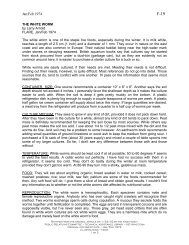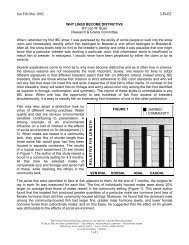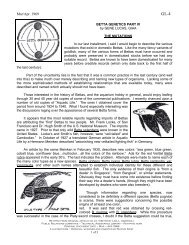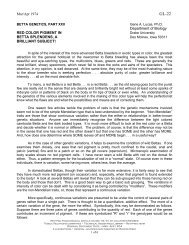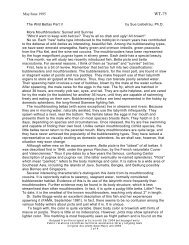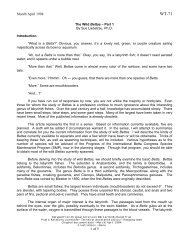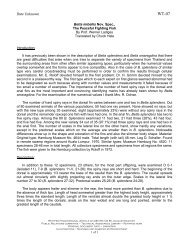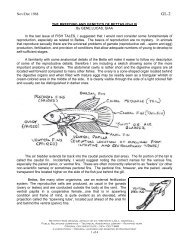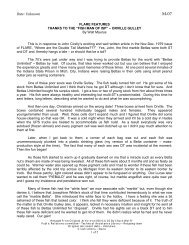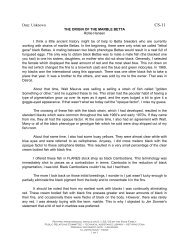WT-72: The Wild Bettas Part II
WT-72: The Wild Bettas Part II
WT-72: The Wild Bettas Part II
- No tags were found...
Create successful ePaper yourself
Turn your PDF publications into a flip-book with our unique Google optimized e-Paper software.
May/June 1994<strong>WT</strong>-<strong>72</strong>(beginning a delightful friendship), who sent me a male. I spawned the pair in April and mailed “BigMama” to Fromm, who spawned her with his remaining male. For a while, we had all the smaragdinawe could desire. Fromm was giving them away. I sold them inexpensively all over the country. Otherhobbyists spawned them. Some shops bought from the breeders.In an attempt to discern the relationship between splendens and smaragdina, breeders matedthe two. I also tried mating smaragdina (a female) to an imbellis male. I could never raise the fry tofree-swimming condition. Lucas was more successful with his crossbreeding attempts. In 1954, I sawthe results of a splendens-smaragdina cross in his laboratory at Drake University. <strong>The</strong> hybrids werepale – sort of a bluish color as I recall – but long-finned. <strong>The</strong>y lacked vigor and were never induced tospawn. <strong>The</strong> fact that they crossbred at all is strong evidence in favor of one species, but one wouldexpect more success in such matings and ability for subsequent spawns.Crossbreeding and chromosome studies were also undertaken in Germany. Dr. H. Grimm, ofthe Zoological Institute at Hamburg University, carried out some of these studies. Grimm, Roloff,Ladiges, and other concluded that was probably a separate species.In the U.S. Ron Cypher carried out several tissue studies comparing smaragdina andsplendens. His results indicated differences, but these were not judged significant. Today, the validityof smaragdina as a separate betta species is doubted by many.Trouble began for smaragdina in 1977. My spawning records for that year indicate very fewmales. <strong>The</strong> trouble which Roloff had had with these bettas repeated itself. My last spawn was in July1978, and was a father-daughter mating. <strong>The</strong> old male hung on while I waited confidently for the malesin the large spawn to reveal themselves. <strong>The</strong>y did not. By then, other breeders were reporting similarratios of few males to many females. I sent the old male to Adelbert Boxley for spawning, but it refusedto mate with his females. As I recognized that none of the fry were male, I requested the old fish again,but it died en route. End of line.Long after my last females died, I heard rumors of males elsewhere in the country. It is possiblethat somewhere, someone is still breeding smaragdina. If so, I would like to know about it. So wouldseveral other breeders, some who remember the lovely “emerald betta”, others who have never seenone.<strong>The</strong> need pointed out by this experience is obvious. Only through a maintained, carefullycontrolled program of species maintenance can a “less than spectacular” aquarium fish be kept in thehobby. <strong>The</strong> smaragdina was a pleasant fish. More importantly, it was crucial to a study of bettas ingeneral. Many questions are raised by its peaceful behavior and its refusal to hybridize in any quantity.Is it a separate species as Roloff and Ladiges claimed, or a variant of Betta splendens? In order tostudy it further, we need live specimens to study, spawn, and enjoy. Hopefully, it will be returned to usone day. I believe that the enthusiasm for it would be much greater the second time around. Losingsomething tends to make us treasure it.Since smaragdina, we have studied several other bubblenesting bettas. Three of these: theimbellis, the Phu Ket stock, and the coccina, will be discussed next month.ReferencesFromm, Dan. “<strong>The</strong> Sorry Saga of Betta smaragdina in Columbus” (2 parts), Fin Features (bulletin ofCentral Ohio Aquarium Society), July-August 1973.Linke, Horst. Farbe im Aquarium labyrinthfishe. Germany, Tetra (no date available).Lucas, Gene. “On the History of <strong>Bettas</strong>,” Freshwater and Marine Aquarium, September 1980.Retyped From Original Article on 08/01/02 By Denise ArchambeaultPublic Relations committee ~ Technical Assistance Library ~ Retyping teamOriginal document date ~ may/june 1994Illustrations ~ one4 of 5
This article has been accepted for inclusion in a future issue of this journal. Content is final as presented, with the exception of pagination.XIE AND RÉGNIER: DEVELOPMENT OF A FLEXIBLE ROBOTIC SYSTEM FOR MULTISCALE APPLICATIONS 5Kinematic configuration of the AFM-RFS for nanoscale pick-and-Fig. 7.place.Fig. 5. Schematic diagrams for (inset I) grasping point searching and (inset<strong>II</strong>) contact detection with amplitude feedback of the dithering cantilever.IV. CONFIGURATION OF 3-D NANOMANIPULATIONA. OverviewIn addition to the microscale pick-and-place, the proposednanotip gripper can also be used to achieve nanoscale pick-andplacein ambient conditions, since the tiny tip is geometricallysharp enough to pick up nanoobjects deposited on the substrate,and simultaneously has capabilities of sensing nanoscale forcebetween the nanoobject and the tool. Moreover, the nanotipgripper itself acts as an image sensor for nanoobject positioning.Fig. 6. Microsphere manipulation protocol. (a) Task planning. (b) Tip I andthe microsphere are in contact. (c) Nanotip gripper is formed. (d) Pick up andrelease the microsphere to its target position.1) System Initialization and Task Planning: Each axis of thenanostage and the piezoscanner are set in a proper position, thussupplying the manipulation with enough travel range on eachaxis. <strong>The</strong>n, the task is planned in Fig. 6(a) with a global viewof the manipulation area that provides coarse positions of themicrospheres and tips.2) Making Tip I Microsphere in Contact: In Fig. 6(b), tip Iis started to approach the microsphere by moving the nanostagewith amplitude feedback to search for the grasping point anddetect contact.3) Forming the Gripper: Similarly, tip <strong>II</strong> approaches the microsphereby moving the piezoscanner. Once tip <strong>II</strong> and the microsphereare in contact, a nanotip gripper is configured in Fig.6(c) for a manipulation.4) Pick-and-Place Micromanipulation: In Fig. 6(d), the microsphereis picked up, transported, and released by movingthe nanostage with a proper displacement on each axis that dependson the diameter of the microsphere and its destination.<strong>The</strong> whole process of 3-D micromanipulation is monitored byreal-time force sensing.B. System Configuration for 3-D NanomanipulationCompared with the 3-D micromanipulation, tip alignmentprecision is the key factor in succeeding the nanoscale pickand-place.<strong>The</strong>refore, the closed-loop nanostage is consideredin this configuration for accurate tip alignment. As shown inFig. 7, the system configuration for 3-D nanomanipulation isreconfigured as follows.1) <strong>The</strong> nanostage is used for image scan with tip I.2) Nanoobjects are supported and transported by thepiezoscanner.3) Tip I, fixed on the motorized stage for coarse positioning, isimmovable during the pick-and-place micromanipulation.Before manipulation, cantilever I acts as an image sensorfor nanoobject positioning.4) For accurate gripper alignment between tip I and tip <strong>II</strong>,tip <strong>II</strong> is fixed on the nanostage rather than the piezoscanner.Tip <strong>II</strong> is supported by the manual stage for coarsepositioning.C. 3-D Nanomanipulation ProtocolNanowires and nanotubes are being intensively investigated.Thus, a protocol is developed here for nanowire or nanotubepick-and-place. However, applications can easily be extendedto, for example, pick-and-place of nanorods or nanoparticlesdispersed on a substrate.1) System Initialization: Once the manipulation area is selectedunder the optical microscope, both the tips are aligned asa quasi-gripper above the center of the manipulation area. Eachaxis of the nanostage and the piezoscanner is initialized at anAuthorized licensed use limited to: UPMC - Universite Pierre et Marie Curie. Downloaded on February 10, 2010 at 07:53 from IEEE Xplore. Restrictions apply.



